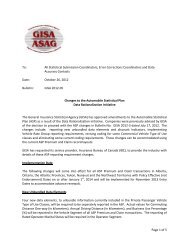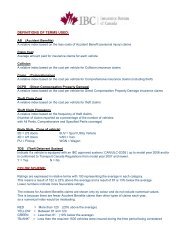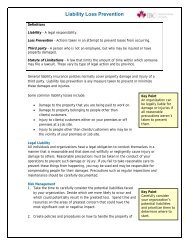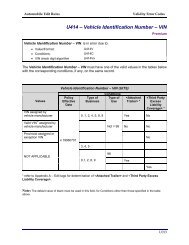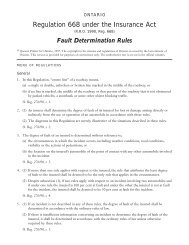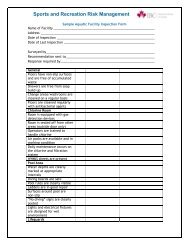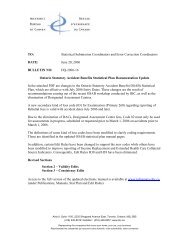Joint IBC & Coalition Coding Practice FAQ #1
Joint IBC & Coalition Coding Practice FAQ #1
Joint IBC & Coalition Coding Practice FAQ #1
Create successful ePaper yourself
Turn your PDF publications into a flip-book with our unique Google optimized e-Paper software.
<strong>Joint</strong> <strong>IBC</strong> & <strong>Coalition</strong> <strong>Coding</strong> <strong>Practice</strong> <strong>FAQ</strong> <strong>#1</strong><br />
Questions often are raised by facilities and insurers about how certain injuries, problems and treatment should<br />
be coded by health care facilities, using OCF claim forms that are submitted through HCAI. Stakeholders<br />
agree that adoption of consistent coding practices is important to improve the reliability of HCDB reports,<br />
which will inform stakeholders about how the auto insurance health system is working. This will also facilitate<br />
fair adjudication by insurance adjusters. HCDB <strong>Coding</strong> <strong>Practice</strong> <strong>FAQ</strong>s (CPF) are designed to improve<br />
stakeholders’ ability to use and comprehend ICD-10-CA 1,2 , CCI 1,3 and GAP codes.<br />
CAUTION<br />
These <strong>FAQ</strong>s are for guidance purposes only, intended to assist health care facilities and<br />
insurers in understanding elements of the injury and intervention codes used on OCF claim<br />
forms. The information supplied in this document has no legal or regulatory authority and<br />
is not to be relied on as legal advice. Many factors unknown to us may affect the<br />
applicability of any statement or comment made in these <strong>FAQ</strong>s to any particular claim.<br />
Health care professionals and insurers must continue to evaluate injury claims individually<br />
based on the merits of each case. Disagreements related to the use or interpretation of<br />
injury and intervention codes will not be resolved by <strong>IBC</strong>, the <strong>Coalition</strong> or by FSCO and<br />
should be discussed between the insured person, the insurer and health practitioner.<br />
GOODS AND SERVICES ARE ADJUDICATED (NOT THE CODE)<br />
All injury and intervention codes transmitted from a provider to an insurer via HCAI are<br />
valid codes. Insurer adjudication decisions are not based on the code used by a provider.<br />
Adjudication decisions will continue to be informed by the reasonableness and necessity<br />
of goods or services for an individual claimant, which are represented by a code. But<br />
submission of a valid code representing proposed goods or services will not necessarily<br />
result in approval of those goods or services.<br />
1 ICD-10-Ca is based upon the International Statistical Classification of Diseases and Related Health Problems,<br />
Tenth Edition (ICD-10). © World Health Organization 1992. All rights reserved.<br />
2 © ICD-10-Ca – Canadian Institute for Health Information<br />
3 © CCI – 2006 Canadian Institute for Health Information<br />
1
<strong>Coding</strong> <strong>Practice</strong> <strong>FAQ</strong> <strong>#1</strong>: Canadian Classification of Health Interventions Codes<br />
(CCI) - Section 7 Codes<br />
The Superintendent’s Professional Services Guideline indicates that administrative overhead charges<br />
associated with medrehab services are to be included in the hourly rates charged by health care facilities for<br />
goods and services.<br />
Expenses related to professional services” as referred to in the SABS and the Professional Services Guideline<br />
include all administration costs, overhead, and related costs, fees, expenses, charges and surcharges. Insurers<br />
are not liable for any administration or other costs, overhead, fees, expenses, charges or surcharges that have<br />
the result of increasing the effective hourly rates, or the maximum fees payable for completing forms, beyond<br />
what is permitted under the Professional Services Guideline. 4<br />
The CCI defines healthcare interventions as follows:<br />
A service performed for or on behalf of a client whose purpose is to improve health, alter or diagnose the<br />
course of a disease (condition), or to promote wellness. 5<br />
Non-overhead Administration<br />
Question<br />
In cases where administrative activities are covered by the SABS, how can these administrative activities<br />
be coded?<br />
Answer:<br />
There are circumstances where non-overhead administrative services may be proposed by facilities and<br />
approved by insurers, although in some cases they may not be covered under the SABS<br />
Examples:<br />
<br />
<br />
Form Completion Fee: When proposing a fee for completion of an OCF 18, the facility would use the<br />
code 7SF30LB (Support activity, documentation for claims form).<br />
Photocopying at request of insurer: If a facility is required to produce a copy of their clinical notes at<br />
the request of the insurer, this is an expense (photocopying) that may be payable by the insurer,<br />
although it is not covered by the SABS. If approved by the insurer, the facility could use CCI – 7SJ30<br />
(Clinical documentation - Correspondence, clinical for external party on behalf of client)<br />
4 Superintendent’s Guideline No. 01/11. Professional Services Guideline.<br />
5 © CCI – 2006 Canadian Institute for Health Information, pg 4.<br />
2
Section 7 CCI Codes (Other Healthcare Interventions)<br />
Question<br />
Section 7 CCI Codes imply that certain interventions, which appear administrative in nature, are considered to<br />
be health-related interventions. Are Section 7 codes valid codes and can they be used on OCF claim forms<br />
transmitted through HCAI?<br />
Answer<br />
Section 7 CCI codes are valid and therefore may be transmitted through HCAI on OCF claim forms. Section 7<br />
codes are categorized as Other Healthcare Interventions and are defined as follows:<br />
Any other service that cannot be described as obstetrical (fetal), therapeutic or diagnostic, but nevertheless,<br />
contributes directly to improve a client’s health, alters the course of a health condition or promotes wellness. 5<br />
All claims for goods and services must be adjudicated on their merits (not based on the code used) and<br />
providers should not expect automatic approval of the services represented by the codes shown below. Not<br />
all of the services listed are authorized by the SABS in all circumstances (e.g. Case Management is authorized<br />
by the SABS only for persons with Catastrophic Impairment). However, in certain circumstances the services<br />
listed below may be determined by health care practitioners and/or insurers to be reasonable and necessary<br />
to improve an insured person’s health after injury in automobile collisions.<br />
3
Table 1: Activities covered under Section 7<br />
Code<br />
7SF12<br />
7SF15<br />
Standard<br />
description<br />
visible to<br />
insurer<br />
Planning,<br />
service<br />
Brokerage,<br />
service<br />
Possible health-related interventions represented by code<br />
1. Team conferences (e.g. scheduling and coordinating team members<br />
and conducting meeting, etc.)<br />
2. Care planning<br />
3. Discharge planning (e.g. communication with hospital staff, CCAC,<br />
transportation arrangements, arranging for equipment, etc)<br />
4. Activity programming<br />
1. Telephone advice (e.g. check ins by patient or by provider to follow<br />
up health status as an alternative to a full clinical visit)<br />
2. Health advice<br />
3. Delegation of clinical support activities (e.g. directing personal<br />
support workers and rehabilitation support workers)<br />
4. Follow up, preventive health care (e.g. post-surgery home check up)<br />
5. Case management (only for persons with catastrophic impairment or<br />
non-catastrophic impairment if optional benefits purchased)<br />
6. Client referral (e.g. if insurer has approved referral to another health<br />
professional)<br />
May involve initiating or maintaining a collaborative process to assess, plan,<br />
implement, coordinate, monitor and/or evaluate the options and services<br />
required to meet a client’s health care needs<br />
GAP Codes (click here) for administrative services are listed under the heading Administrative/Other Services.<br />
CCI Codes (click here) for administrative health-related interventions as listed in Section 7 of the CCI (click here for CCI)<br />
4
Health Facility Must Provide Service Details<br />
As shown, the Section 7 codes represent a group of several services. The code does not tell the adjuster which<br />
specific service is being recommended. Providers need to use the narrative section of the OCF to ensure that<br />
an insurer knows what services are proposed and require adjudication. If the insurer doesn’t know specifically<br />
what service is being proposed, they will not be able to approve it. To learn how to use the narrative parts of<br />
OCF, refer to the document called “<strong>Coding</strong>: Meant to Classify Not Inform Adjudication” available on the HCAI<br />
Information website.<br />
Health Care Facilities<br />
Prior to submitting expenses using the codes 7SF12 and 7SF15, certifying health practitioners may wish to ask:<br />
<br />
<br />
<br />
<br />
<br />
<br />
Will these services contribute directly to improve a client’s health, alter the course of a health<br />
condition or promote wellness? How will this be measured?<br />
Have cognitive, physical, emotional or behavioural challenges been communicated to the insurer?<br />
Have social, family, environmental or vocational issues been communicated to the insurer?<br />
Is the insurer aware that the patient is/is not attending regular clinical visits outside the home<br />
(if applicable)?<br />
Have I supplied the insurer with an explanation of why these services are necessary (this must be done<br />
on the narrative part of the OCF 18)?<br />
o Why is a team meeting necessary? Which team members need to be involved? What happens<br />
if the team meeting doesn’t happen?<br />
o Why is care planning required in addition to routine treatment planning?<br />
o Why is discharge planning required? How will the provider supplement the discharge<br />
planning supplied by the institution from which the patient is being discharged?<br />
o Why is activity programming required? Why is it not included as part of the routine treatment<br />
planning process?<br />
Have I explained why these are not services that are a routine part of a treatment visit?<br />
Have I supplied the insurers with enough information to understand the consequences to the injured<br />
person if these services are declined?<br />
5
Insurers<br />
Prior to approving or declining expenses submitted under Section 7 codes, insurers may want to consider the<br />
circumstances of each injured claimant. For example:<br />
<br />
Will these services contribute directly to improve a client’s health, alter the course of a health condition or<br />
promote wellness? How will this be measured?<br />
<br />
Are there cognitive, physical, emotional or behavioural challenges experienced by the claimant? Are there<br />
social, family, environmental or vocational issues that need to be addressed?<br />
<br />
Is there an explanation with details of the services required in the narrative part of the OCF 18; or has the<br />
facility contacted me with that information?<br />
• Will a team meeting with the team members listed help promote better use of<br />
medrehab resources and improved recovery?<br />
• Will care planning as described promote better use of medrehab resources and<br />
improved speed or quality of recovery?<br />
• Is discharge planning required? How will the provider supplement the discharge<br />
planning supplied by the institution from which the claimant is being discharged?<br />
• Is activity programming required? Why is it not included as part of the routine<br />
treatment planning process?<br />
<br />
Is it clear that these are not services that are routinely included as part of a treatment visit?<br />
<br />
What are the consequences to the injured person if these services are declined?<br />
6



